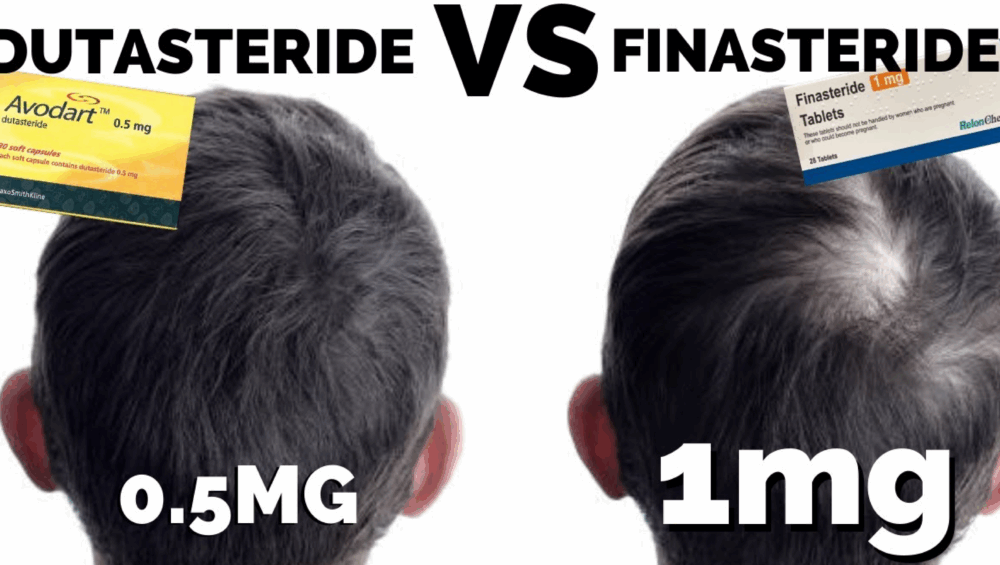When patients ask me about treatment for male pattern baldness, the discussion often turns to Finasteride vs Dutasteride. Both medicines were first designed with the prostate in mind, yet we now use them widely in hair loss because they lower levels of dihydrotestosterone (DHT). DHT is the hormone that causes hair follicles in genetically prone men to slowly shrink and produce thinner strands until they stop growing altogether. By reducing DHT, these drugs can help men hold on to the hair they still have and, in some cases, see a bit of regrowth. Both medications are effective, but they act differently, and that distinction can be important.
How They Work
Finasteride mainly targets one form of the enzyme that converts testosterone into DHT, called type II 5-alpha reductase. This enzyme is found in higher amounts in the scalp and the prostate, which explains why the drug helps both hair loss and prostate enlargement. By cutting back on DHT in these areas, finasteride slows down the process by which hair follicles shrink and produce thinner hair over time.
Dutasteride goes a step further. It blocks not only the type II enzyme but also type I, which is found in other tissues like the skin. Because of that, dutasteride brings overall DHT levels down much more than finasteride does. In everyday practice, this stronger effect can make dutasteride a better choice for men with more noticeable thinning, or for those who tried finasteride and did not get the results they were hoping for. (tau.amegroups.org)
Finasteride vs Dutasteride and Prostate Health
The discussion of finasteride vs dutasteride prostate effects is important. Both medicines were first designed to help men with an enlarged prostate, a condition we call benign prostatic hyperplasia (BPH). When the prostate grows, it can press on the bladder and urethra, leading to frequent urination or difficulty starting and stopping the stream.
When these drugs lower DHT, the prostate tends to shrink, which usually makes urination easier. Over time, finasteride also received approval in the U.S. for treating hair loss, while dutasteride remained approved only for prostate problems here, even though many doctors still use it for hair as well. That said, many doctors still use dutasteride off-label for hair loss, and in places like South Korea and Japan, it is already recognized as a standard treatment for male pattern baldness.
Price and Accessibility
When people ask about finasteride vs dutasteride price, finasteride almost always comes out cheaper. The generic has been around for a long time, so it is easy to find and usually very affordable. Dutasteride used to be quite a bit more expensive, but with generics now available, the gap has narrowed. Still, depending on where you live and which pharmacy you use, dutasteride can cost more. Since these medicines need to be taken long-term to keep working, price is often part of the decision-making. (miiskin.com)
Side Effects and Safety Considerations
As with any medication, side effects are a concern. Both finasteride and dutasteride may cause sexual side effects in a small percentage of men, such as decreased libido or erectile difficulties. Another area of interest is the discussion of finasteride vs dutasteride depression. I do occasionally hear from patients that their mood feels different while on these medications, and a few have described symptoms of depression. The studies we have do not give us a clear answer on whether the drugs truly cause this, but I think it is worth keeping an eye on, especially for men who have dealt with depression or anxiety in the past.
Effectiveness in Hair Restoration
When comparing results, dutasteride has been shown in studies to be more potent in lowering DHT levels and can provide greater improvements in hair density and thickness. Even so, I usually start patients on finasteride first. It has been around longer, we know a lot about its safety, and it is the one officially approved for hair loss in the U.S. If someone does not see the improvement they were hoping for, that is when I might bring up dutasteride as the next option.
Long-Term Commitment
It is important to remember that these medications require ongoing use. If you stop taking the medication, your DHT levels go back up, and the hair loss usually starts again. I tell patients to think of these treatments as maintenance rather than a cure. As long as you keep taking them, you hold on to the benefits. Sometimes we also pair them with other options, like minoxidil or platelet-rich plasma treatments, to get a bit more improvement.
Final Thoughts
Both finasteride and dutasteride can help men manage hair loss, but the right choice is not the same for everyone. Finasteride is often the first option because it is more affordable, it has official approval for hair loss, and we have many years of safety data on it. Dutasteride lowers DHT more strongly, so I consider it for men who have more advanced thinning or who do not see the results they want with finasteride.
The decision comes down to the individual. Your medical background, your budget, and your goals all play a role in determining which medicine fits best. This is why I recommend a proper consultation. The safest way forward is to go over the options with a doctor who can shape the treatment to your needs.






